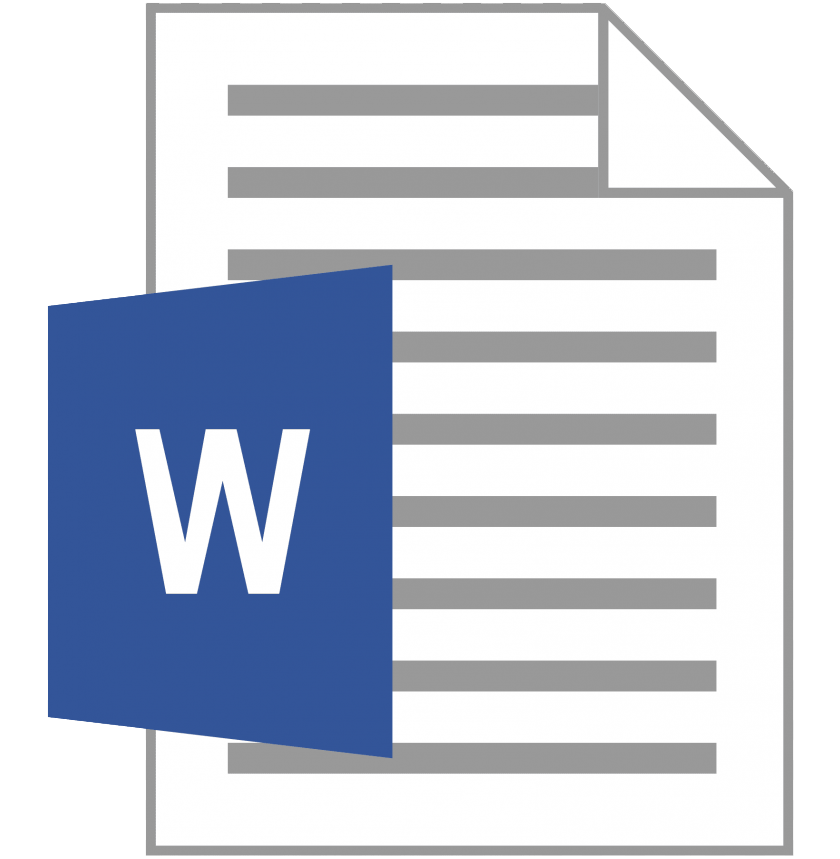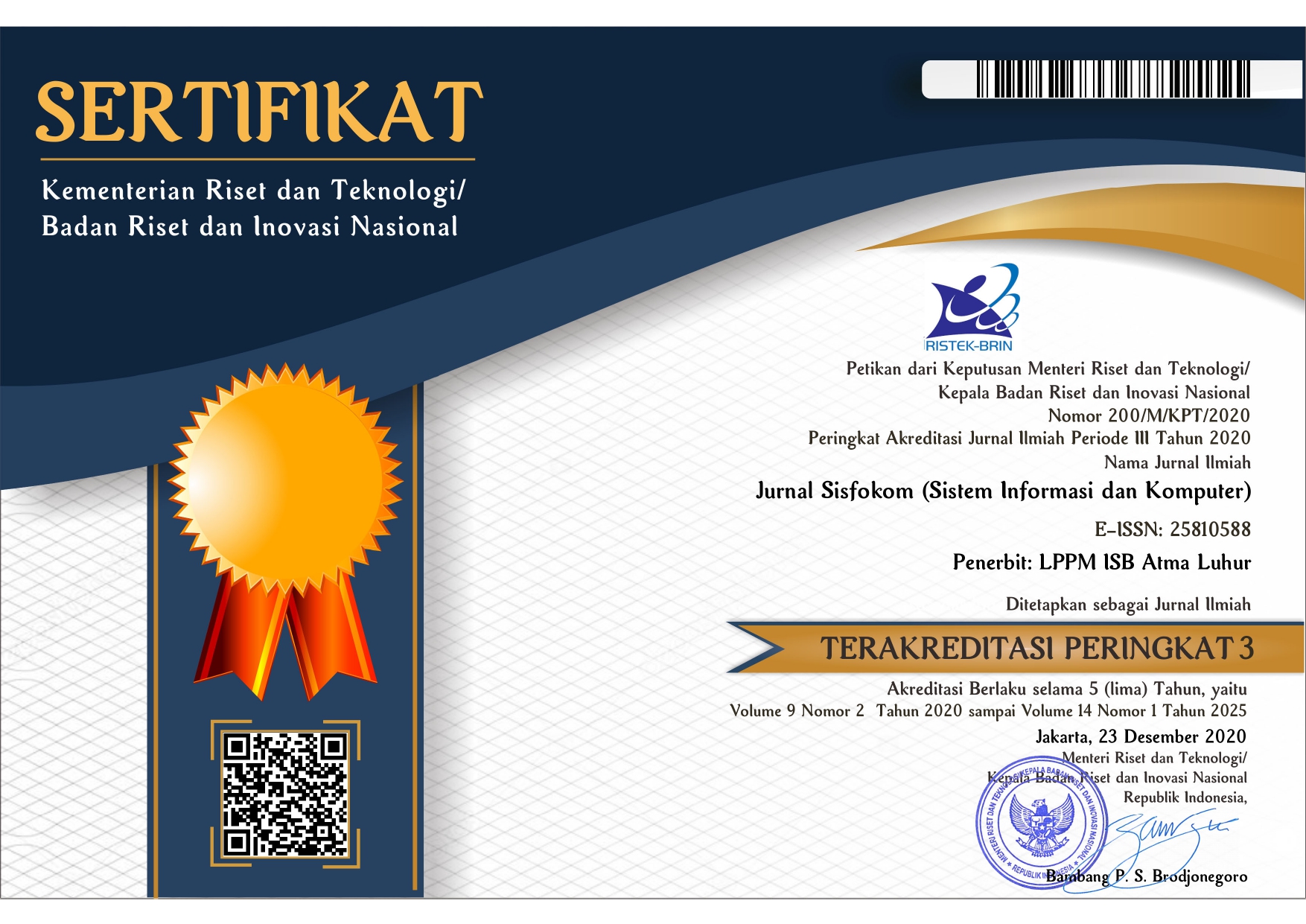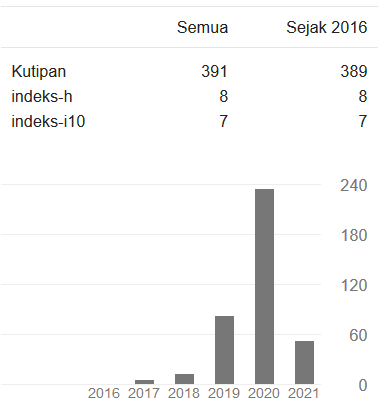Game and Application Purchasing Patterns on Steam using K-Means Algorithm
DOI:
https://doi.org/10.32736/sisfokom.v13i3.2214Keywords:
Clustering, CRISP-DM, Game, K-Means, Purity, Silhouette CoefficientAbstract
Online games are visual games that utilize the internet or LAN networks. With the growth of the gaming industry, platforms like Steam offer a wide variety of games, making it challenging for users to decide which game to play. This study employs the Cross-Industry Standard Process for Data Mining (CRISP-DM) methodology to address this issue by understanding user preferences. The k-means algorithm clusters game data based on similar characteristics, helping users and developers identify the most popular game types. Data sourced from Kaggle, obtained through the Steam API and Steamspy, consists of 85,103 entries. A normalization process is applied to enhance calculation accuracy. The elbow method determines the optimal number of clusters, resulting in three clusters from the k-means algorithm. The evaluation includes the silhouette coefficient, which measures the proximity between variables, and precision purity, which compares labels by assigning a value of 1 (actual) or 0 (false). The study finds an average silhouette coefficient of 0.345 and a precision purity value of 0.734, indicating that the k-means algorithm performs optimally based on the precision purity metric. The findings reveal that free-to-play games are the most popular among users, while the "Animation & Modelling" category is the most expensive based on price comparisonsReferences
R. Machfiroh, A. Rahmansyah, and A. Budiman, “The Effect of Massively Multiplayer Online Game on Player Behaviour,” in Journal of Physics: Conference Series, IOP Publishing Ltd, Feb. 2021. doi: 10.1088/1742-6596/1764/1/012081.
D. Bai, L. Chen, Z. Shang, Y. Wang, and G. Guan, “E-sports Industry, Video Game Industry and Economic Growth: An Empirical Research in China,” 2022. doi: 10.2139/ssrn.4074000.
C. H. Cheng and S. F. Huang, “A novel clustering-based purity and distance imputation for handling medical data with missing values,” Soft comput, vol. 25, no. 17, pp. 11781–11801, Sep. 2021, doi: 10.1007/s00500-021-05947-3.
S. Wijaya, N. Nur Setyo, and W. Nur Azizah, “Potential Analysis And Supervision Of VAT On The Utilization Of Digital Contents (Case Study: Steam Platform,” Dinasti International Journal Of Digital Business Management, vol. 1, no. 3, 2020, doi: 10.31933/dijdbm.v1i3.238.
Z. Wang, V. Chang, and G. Horvath, “Explaining and Predicting Helpfulness and Funniness of Online Reviews on the Steam Platform,” Journal of Global Information Management, vol. 29, no. 6, 2021, doi: 10.4018/JGIM.20211101.oa16.
I. Busurkina, V. Karpenko, E. Tulubenskaya, and D. Bulygin, “Game Experience Evaluation. A Study of Game Reviews on the Steam Platform,” in Digital Transformation and Global Society, D. A. Alexandrov, A. V. Boukhanovsky, A. V. Chugunov, Y. Kabanov, O. Koltsova, I. Musabirov, and S. Pashakhin, Eds., Cham: Springer International Publishing, 2022, pp. 117–127. doi: 10.1007/978-3-030-93715-7.
K. P. Sinaga and M. S. Yang, “Unsupervised K-means clustering algorithm,” IEEE Access, vol. 8, pp. 80716–80727, 2020, doi: 10.1109/ACCESS.2020.2988796.
B. Zhang, L. Wang, and Y. Li, “Precision Marketing Method of E-Commerce Platform Based on Clustering Algorithm,” Complexity, vol. 2021, 2021, doi: 10.1155/2021/5538677.
A. Moubayed, M. Injadat, A. Shami, and H. Lutfiyya, “Student Engagement Level in an e-Learning Environment: Clustering Using K-means,” American Journal of Distance Education, vol. 34, no. 2, pp. 137–156, Apr. 2020, doi: 10.1080/08923647.2020.1696140.
L. Pamungkas, N. A. Dewi, and N. A. Putri, “Classification of Student Grade Data Using the K-Means Clustering Method,” Jurnal Sisfokom (Sistem Informasi dan Komputer), vol. 13, no. 1, pp. 86–91, Feb. 2024, doi: 10.32736/sisfokom.v13i1.1983.
S. Ariska, D. Puspita, and I. Anggraini, “Comparison Of K-Means and K-Medoids Algorithm for Clustering Data UMKM in Pagar Alam City,” Jurnal Sisfokom (Sistem Informasi dan Komputer), vol. 13, no. 2, pp. 193–199, Jun. 2024, doi: 10.32736/sisfokom.v13i2.2090.
A. Abdulhafedh, “Incorporating K-means, Hierarchical Clustering and PCA in Customer Segmentation,” Journal of City and Development, vol. 3, no. 1, pp. 12–30, 2021, doi: 10.12691/jcd-3-1-3.
S. D. K. Wardani, A. S. Ariyanto, M. Umroh, and D. Rolliawati, “Comparison of K-Means, Db Scanner & Hierarchical Clustering Method Results for Market Segmentation Analysis,” JIKO (Jurnal Informatika dan Komputer), vol. 7, no. 2, p. 191, Sep. 2023, doi: 10.26798/jiko.v7i2.796.
D. P. Agustino, I. G. B. A. Budaya, I. G. Harsemadi, I. K. Dharmendra, and I. M. S. A. Pande, “Comparison of the DBSCAN Algorithm and Affinity Propagation on Business Incubator Tenant Customer Segmentation,” Jurnal Sisfokom (Sistem Informasi dan Komputer), vol. 12, no. 2, pp. 315–321, Jul. 2023, doi: 10.32736/sisfokom.v12i2.1682.
M. Sarkar, ✉ Aisharyja, R. Puja, and F. R. Chowdhury, “Optimizing Marketing Strategies with RFM Method and K-Means Clustering-Based AI Customer Segmentation Analysis,” Journal of Business and Management Studies, 2024, doi: 10.32996/jbms.2024.6.2.5.
C. Schröer, F. Kruse, and J. M. Gómez, “A systematic literature review on applying CRISP-DM process model,” in Procedia Computer Science, Elsevier B.V., 2021, pp. 526–534. doi: 10.1016/j.procs.2021.01.199.
J. F. Pimentel, L. Murta, V. Braganholo, and J. Freire, “Understanding and improving the quality and reproducibility of Jupyter notebooks,” Empir Softw Eng, vol. 26, no. 4, Jul. 2021, doi: 10.1007/s10664-021-09961-9.
S. Chandel, C. B. Clement, G. Serrato, and N. Sundaresan, “Training and Evaluating a Jupyter Notebook Data Science Assistant,” 2020. [Online]. Available: www.aaai.org
C. H. Cheng and S. F. Huang, “A novel clustering-based purity and distance imputation for handling medical data with missing values,” Soft comput, vol. 25, no. 17, pp. 11781–11801, Sep. 2021, doi: 10.1007/s00500-021-05947-3.
D. Solunke, G. Deshmukh, S. Wagh, A. Agrawal, and I. Priyadarshini, “Unlocking The Genres: Multilabel Anime Genre Predicition,” International Research Journal of Modernization in Engineering Technology and Science , vol. 05, no. 04, 2023, [Online]. Available: www.irjmets.com
F. Aldi, F. Hadi, N. A. Rahmi, and S. Defit, “Standardscaler’s Potential In Enhancing Breast Cancer Accuracy Using Machine Learning,” Journal of Applied Engineering and Technological Science, vol. 5, no. 1, pp. 401–413, 2023, doi: 10.37385/jaets.v5i1.3080.
H. Humaira and R. Rasyidah, “Determining The Appropiate Cluster Number Using Elbow Method for K-Means Algorithm,” in Proceedings of the 2nd Workshop on Multidisciplinary and Applications (WMA), European Alliance for Innovation n.o., Mar. 2020. doi: 10.4108/eai.24-1-2018.2292388.
D.-T. Dinh, T. Fujinami, and V.-N. Huynh, “Estimating the Optimal Number of Clusters in Categorical Data Clustering by Silhouette Coefficient,” in Knowledge and Systems Sciences, J. Chen, V. N. Huynh, G.-N. Nguyen, and X. Tang, Eds., in Communications in Computer and Information Science, vol. 1103. Singapore: Springer Singapore, 2019, pp. 1–17. doi: 10.1007/978-981-15-1209-4.
I. Aljarah, M. Mafarja, A. A. Heidari, H. Faris, and S. Mirjalili, “Multi-verse optimizer: Theory, literature review, and application in data clustering,” in Studies in Computational Intelligence, vol. 811, Springer Verlag, 2020, pp. 123–141. doi: 10.1007/978-3-030-12127-3_8.
Downloads
Published
Issue
Section
License
The copyright of the article that accepted for publication shall be assigned to Jurnal Sisfokom (Sistem Informasi dan Komputer) and LPPM ISB Atma Luhur as the publisher of the journal. Copyright includes the right to reproduce and deliver the article in all form and media, including reprints, photographs, microfilms, and any other similar reproductions, as well as translations.
Jurnal Sisfokom (Sistem Informasi dan Komputer), LPPM ISB Atma Luhur, and the Editors make every effort to ensure that no wrong or misleading data, opinions or statements be published in the journal. In any way, the contents of the articles and advertisements published in Jurnal Sisfokom (Sistem Informasi dan Komputer) are the sole and exclusive responsibility of their respective authors.
Jurnal Sisfokom (Sistem Informasi dan Komputer) has full publishing rights to the published articles. Authors are allowed to distribute articles that have been published by sharing the link or DOI of the article. Authors are allowed to use their articles for legal purposes deemed necessary without the written permission of the journal with the initial publication notification from the Jurnal Sisfokom (Sistem Informasi dan Komputer).
The Copyright Transfer Form can be downloaded [Copyright Transfer Form Jurnal Sisfokom (Sistem Informasi dan Komputer).
This agreement is to be signed by at least one of the authors who have obtained the assent of the co-author(s). After submission of this agreement signed by the corresponding author, changes of authorship or in the order of the authors listed will not be accepted. The copyright form should be signed originally, and send it to the Editorial in the form of scanned document to sisfokom@atmaluhur.ac.id.









